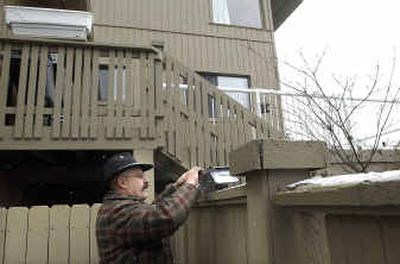Critter-ridder

The thing about varmints is that they’re pesky. The wily little and not-so-little buggers can destroy property, carry disease, elude capture and reproduce like proverbial rabbits. Just ask the folks at the Kootenai County Fairgrounds. Last July they had a problem with rockchucks, a woodchuck-like critter.
“We had 20 of them digging holes everywhere,” said Jon Johnson, maintenance supervisor. “Pretty much they were breeding like rabbits.” The fair considered setting its own traps but worried about having traps in the presence of children.
So the fair called in a professional critter-ridder – Dave Morelli.
“He knew what he was doing,” Johnson said. “Our problem was solved.”
For close encounters of the varmint kind, Morelli is the man to call. He doesn’t advertise, but his name and business, “Pesky Varmints,” is known to grateful homeowners and by Fish and Game and local exterminators who often refer people to him.
He’ll handle just about any kind of four-legged critter that’s making a nuisance of itself, including squirrels, rats, marmots, raccoons, coyotes, muskrats, otters and beavers. He doesn’t do insects anymore and prefers not to do gophers, but when he does, limits gopher service to small yards.
“I don’t do big expanses of yards,” he said. “I can catch three gophers a day in the same trap.”
Even the cutest of critters can wreak havoc. “Squirrels will get into the attic and displace insulation. They drill holes. They can chew wires and cause fires. People block them off, then they chew through the drywall,” Morelli explained.
Likewise, raccoons get into crawl spaces and tear up insulation. They also carry disease. Besides their spray factor, skunks have a high incidence of rabies, Morelli said.
Otters don’t cause damage, but they do defecate on docks and on boats and leave the remains of fish they’ve eaten. “I try to catch them alive and put them somewhere else,” he said.
“Pesky Varmints provides us citizens with a service not available elsewhere,” said Dave Nussear of Dalton Gardens, who had skunks in his horse barn and called Morelli. “You can get traps from the Department of Fish and Game, but then what?
“[Morelli] takes it and does whatever he does with it.”
Depending on the animal, Morelli either relocates it or euthanizes it.
Morelli says animals that have been trapped and released once before are harder to catch. “A lot of people borrow a trap from Fish and Game and then release [the animal] and it goes to someone else’s home, and I have to use a different kind of trap.”
Some animals are wily by nature. “Coyotes are the hardest to catch. They have to be fooled into stepping into a trap. … you have to boil the traps to get all the odor off and bury it.”
Not catching neighborhood pets provides another challenge. Morelli often uses cat food and dog food as bait. If there are a lot cats around, he has to find another lure. “I had one cat I caught in a coon [box] trap. I shook it up so he wouldn’t want to come back.” But the cat did come back – twice.
“I guess it was just worth it to get caught to eat what I had,” Morelli said. “He was a nice cat; he just kept getting in my way.”
Morelli charges a $150 set-up fee plus $50 per animal. His fee includes an inspection to figure out what the pest is and often multiple trips to remove animals from the traps. He leaves the traps until no more varmints are caught.
Sometimes he has to do a little detective work to figure out what the problem is.
“I have a little reputation for finding things in walls,” he says. “I have a stethoscope and listen and can tell what it is. Most of the time I try to catch an animal so I don’t make holes in the wall. …
“The trick is knowing animals and their habits.”